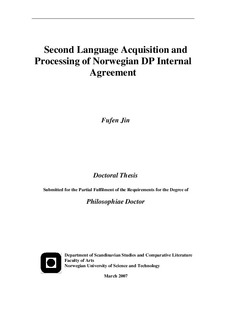| dc.description.abstract | The primary goal of this study is to determine whether adult second language learners ultimately achieve linguistic competence that is identical to that of native speakers, not only at the level of grammatical knowledge but also at the level of processing. This issue is addressed through investigating the production and perception of Norwegian Determiner Phrase (DP) internal agreement by endstate L2 speakers of Norwegian. Participants in the experiment include three different L2 groups (L1 English, L1 Italian/Spanish, and L1 Chinese), and a native control group.
The target language, Norwegian, has DP-internal agreement between determiners, attributive adjectives, and nouns in terms of gender, number, and definiteness. Based on Julien’s (2005) DP model, D and α heads in Norwegian are assumed to carry uninterpretable gender, number and definiteness features. The source languages in question differ parametrically from the target language with respect to one, two or all of the uninterpretable features relevant for DP internal agreement. The informants are tested on two tasks: an online DP production task, and an auditory naming task. The purpose of the DP production task is to determine whether the uninterpretable features will be present in the interlanguage grammar regardless of status of the corresponding features in the L1s; the purpose of the auditory naming task is to examine whether L2 learners will be sensitive to the agreement cues on D when processing L2 Norwegian, and whether their sensitivity (or insensitivity) to the agreement cues is directly related to how well they produce the correct agreements.
Results from the on-line DP production task divide the L2 participants into two groups: some informants (referred to as G1 participants) performed in a nativelike way, while the others (referred to as G2 participants) showed a strong L1 effect—those uninterpretable features which are not instantiated in L1s are areas of persistent difficulty in these L2 speakers. Results from the auditory naming task show that endstate L2 speakers do not process Norwegian DP internal agreement in a nativelike fashion. While native speakers are sensitive to the agreement cues on D, L2 speakers are totally insensitive to the grammatical agreement violations in L2 grammar. This observation indicates that L2 processing is less automatic and involves less full syntactic computation than L1 processing. A comparison of G1 and G2 participants reveals a remarkably similar processing pattern — neither group shows sensitivity to the agreement cues on D, contra to what has been found in native speakers. This finding indicates that adult L2 speakers have not attained nativelike processing, even after they have attained nativelike grammatical knowledge, suggesting that certain processing mechanisms are subject to a critical period. | nb_NO |
